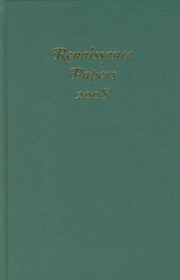Book contents
- Frontmatter
- Contents
- Renaissance Papers
- Cardinal Wolsey: The English Cardinal Italianate
- Pope Gregory and the Gens Anglorum: Thomas Stapleton's Translation of Bede
- The Spenserian Paradox of Intended Response
- Lucan, Marlowe, and the Poetics of Violence
- Hell Is Discovered
- Private and Public Plays in the Private Theaters: Speculation on the Mercenary Methods of Second Paul's and Second Blackfriars
- Staging Dismemberment in Early Modern Drama: Playing Mnemonics and Meaning
- Serving Theater in Volpone
- Troilus and Cressida: An Epitaph for the History Play
- “What thing thou art, thus double-formed”: Naming, Knowledge, and Materialism in Paradise Lost
Staging Dismemberment in Early Modern Drama: Playing Mnemonics and Meaning
Published online by Cambridge University Press: 12 September 2012
- Frontmatter
- Contents
- Renaissance Papers
- Cardinal Wolsey: The English Cardinal Italianate
- Pope Gregory and the Gens Anglorum: Thomas Stapleton's Translation of Bede
- The Spenserian Paradox of Intended Response
- Lucan, Marlowe, and the Poetics of Violence
- Hell Is Discovered
- Private and Public Plays in the Private Theaters: Speculation on the Mercenary Methods of Second Paul's and Second Blackfriars
- Staging Dismemberment in Early Modern Drama: Playing Mnemonics and Meaning
- Serving Theater in Volpone
- Troilus and Cressida: An Epitaph for the History Play
- “What thing thou art, thus double-formed”: Naming, Knowledge, and Materialism in Paradise Lost
Summary
THE threat of physical fragmentation became a particularly harrowing concept to the minds of Elizabethans and infiltrated the philosophies and literature of the age. Gail Kern Paster argues that individuals struggled to maintain control over their own bodies by enforcing a regiment of shame to discipline bodily functions, all while anxieties over the unknown, uncontrollable body—the vulnerable essence of self—permeated the theatrical and psychological worlds of the English Renaissance. As Canutus explains in the anonymously printed Edmond Ironside, the loss of hands and nose was punishment “worse than loss of life, / For it is a stinging corsive to [the soul],” and an “earmark to know a traitorous villain by.” Violating the physical integrity of his prisoner's bodies would illustrate their incapacity to govern their own corporeal states while simultaneously establishing Canutus's power over them. His victims, he claims, would rather die than live “earmarked” for life, and his speech illuminates the horrific threat any physical attack on the sacred body posed to the early modern man and woman. The mysterious boundaries of their inner and outer bodily realities could be ravaged and their ignominy branded by the end of a knife. The injured body manifested what Paster refers to as “dense inner workings” of the projected self and made previously internalized concepts, or secrets, “curiously external and tangible.”
- Type
- Chapter
- Information
- Renaissance Papers 2008 , pp. 113 - 124Publisher: Boydell & BrewerPrint publication year: 2009



